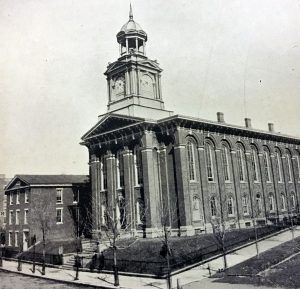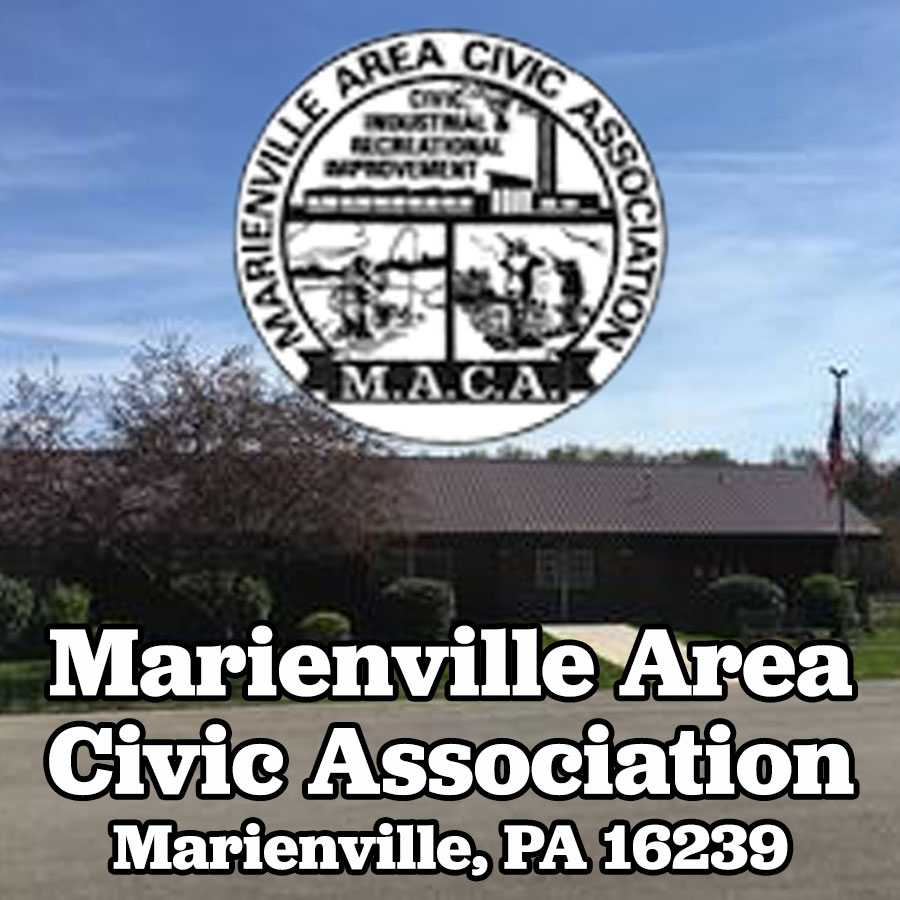Written by Dave Taylor |Interior Photos provided by Dave Taylor |Cover photo by Kyle Yates
This is the third and final article focused upon the history of the Jefferson County Court House, a landmark that celebrates its sesquicentennial this year. The combined three articles will be published in the Jeffersonian Journal, published by the Jefferson County Historical Society. The first two articles chronicled the life of the Court House from its 1869 construction to the 1902 erection of a drinking fountain in front of the Court House on Brookville’s Main Street. This third piece deals with the 1927 remodeling and addition to the 1869 building and follows its general history to the present.
For the first half-century of its long life, the Court House underwent little physical change. The rectangular footprint remained the same, with the building accessed by a straight-run stair centered on the façade. A cast iron fence surrounded the building on three sides, also enclosing the 1832 brick jail that stood immediately west of the Court House. Flanking the stairway were two groups of cannon balls, likely remnants from the Civil War. They survived into the early years of the twentieth century but likely fell victim to the scrap metal drives of World War One. The Jefferson County Court House has hosted a wide variety of events over the decades. In the early years, several public hangings were held on the lawn between the Court House and the Jail. Those grisly events notwithstanding, one of the most unique events occurred in 1922 when a steeplejack climbed to the top of the cupola of the bell tower. The Jeffersonian Democrat reported,
P. J. O’Brien, a traveling steeplejack of everywhere in general and nowhere in particular, breezed into Brookville last Friday and just about supper time entertained a big crowd by climbing to the top of the Court House cupola without entering the building. O’Brian had himself lashed into a strait jacket and hoisted by the heels to the cornice of the Court House. Hanging head downward, he rid himself of the jacket and then climbed up over the cupola. A hat was passed for his benefit.
The Courtroom itself has always been located on the second floor and has served as the venue for numerous public meetings and events. In addition to shenanigans such as O’Brien’s daring–foolhardy?–1922 ascent and formal court activities, political rallies were held here, civic groups such as the W. C. T. U. met here, and the occasional musical program was given here, although the newspaper did complain about the acoustics! In later, more recent years, nonprofit groups have held events in both the Large and Small Courtroom including plays, historical meetings, and presentations by speakers.
By the 1920s, the County’s needs were outgrowing its 50-year-old seat of justice. Expanded office space was needed for the various County row officers; this name dates from the 1860s when officers such as the Prothonotary, Register and Recorder, Treasurer, etc. had their offices side-by-side in a row on th e first floor of the Court House. As early as 1922, plans were being developed for improvements to the building.
e first floor of the Court House. As early as 1922, plans were being developed for improvements to the building.
Under the heading ELABORATE PLANS FOR ALTERING COURT HOUSE, the Democrat reported
Plans for completely remodeling the Court House and Jail at Main and Pickering Streets are on exhibition at the County Commissioners’ Office, having been drawn by the Emmett E. Bailey Company, of Oil City. ‘ Originally, the idea was to make such additions to the rear of the Court House, along Cherry Alley, as would provide additional space for court purposes and probably a fireproof vault or two for records which now are in constant peril of destruction. This idea has grown until, according to the Bailey plans, nothing will be left of the present buildings except the shell of the Court House. The Jail would be razed and the Sheriff’s Office, with detention cells, would be in an L running across the back of the lot on Cherry Alley toward the American Hotel. The fence about the Court House plot would disappear. The basement would be converted into office space and would house a public comfort station for women, County Superintendent’s Office, Farm Bureau, and fireproof vaults. Other fireproof vaults would be on other floors. The basement would be entered on the Main Street level. The present first floor of the Court House would be taken up principally by the Prothonotary’s, Commissioners’ and Treasurer’s Offices. Space for the minor offices, like the Jury Commissioners and County Auditors, would be provided. A large and small court room would be provided on the second floor, with rooms for jurors of both sexes, etc. on the second and third floors as convenient. A private judge’s chamber would be provided, and the Law Library would have ample room. A drafting room for the county surveyor would be on top floor. Specifications for the proposed work have not been drawn in detail. It is  estimated that the cost would be not less than $100,000.
estimated that the cost would be not less than $100,000.
An interesting sidelight to this discussion is that the leadership of Methodist Church, fearing that the Court House expansion might back up completely to their building, to protect themselves purchased the lot just north of Cherry Alley and demolished an existing old house that occupied that lot. On February 28, 1929. The Brookville Amercian reported, with the headline RAZE OLD HOME TO BEAUTIFY SPOT, “Another of Brookville’s landmarks is to go. The building on the old Blood property on N. Pickering Street, between the Court House and the Methodist Church, is to be torn down and the landscape plotted. This property belongs to the church, having been purchased by the trustees ten years ago when it was mentioned as a probable site for a jail building. Considerable agitation was aroused at the time over the possibility of the jail being built up against the church, and the trustees bought it to assure that no objectionable building would be placed there. It will not only add greatly to the beauty of the church building, but it was also set off the Court House to great advantages.”
As early as 1923 the County Commissioners advertised for bids for the project. At that time no registered architect lived in Jefferson County, and Emmett Bailey of Oil City was chosen to design the project. He was a regionally-prominent practitioner who had designed the new Brookville Hospital in 1919. Heated discussions ensued over the next years until bids were finally opened in February, 1927. Brookville contractor Ray H. Richards was the low bidder at $267,000. A motion was offered that the Commissioners turn the issue over to a grand jury, but that motion died for the lack of a second. Another motion was offered and passed 2-1, with Commissioner Perry Wingert dissenting.
The proposed Court House project was not without its other detractors. Letters to the Editor decried the renovation of a 50-year-old building and at least one legal attempt sought to halt the process. In March 1927, an injunction was filed that was heard by Venango County Judge W. M. Parker. Judge Parker denied the injunction and the project went on.
The 1927-1928 project resulted in the area around the Court House to be excavated, allowing for larger windows to penetrate the foundation and to allow natural light into the renovated basement. The main entrance remained centered on the façade, but a forward-projecting granite entryway replaced the 1867 straight-run stair, incorporating a grand staircase of two opposing circular runs of granite, wrought iron railings and a series of wrought iron lights posts with acorn-top globes.
In 1927, just as all County activities had been disrupted with the 1866-1869 construction of the Court House, the Commissioners were faced with a space dilemma. They leased the 1915 Brookville Park Auditorium, located on part of the Fairgrounds, a building later known as the “White Elephant.” The offices and the Court moved into the building which was renovated and the stage was remodeled to serve as a courtroom. The Jeffersonian Democrat of May 12, 1927 reported.
Jefferson County offices will soon be doing business in the Brookville Park Building. Work of moving was started several days ago and the next few days will see all the Court House offices located in their temporary home where they will remain until the reconstruction of the present Court House is completed. The Judge’s chambers, law library and court room fixtures were the first to be moved; yesterday the moving of the Commissioners’ office was completed, and the removing of the other offices will be carried thru as rapidly as possible. The arrangement of the offices in the Park Building will be similar to their arrangement in the Court House. Immediately inside the entrance, the office of Judge Darr will be found on the right and directly opposite will be the office of C. A. Anderson, County Superintendent of Schools. Passing thru the lobby and into the main auditorium, the offices of the Register and Recorder and County Commissioners will be found on the right side of the building and those of the Prothonotary and County Treasurer will be located on the left. Space for the Sheriff and Jefferson County Farm Bureau will also be provided. The stage of the Park Building has been arranged as a court room, with the Judge’s bench, jury box, and chairs for attorneys and witnesses. There will be very little, if any, room for spectators, [but] it is thought the space will be ample for necessary requirements. The first session of court in the temporary quarters will be naturalization court, which will be held early in June.
The Court House itself was not the only building impacted by the reconstruction project. The adjacent Jail and Sheriff’s Residence was older yet, having been built in 1832. Architect Bailey examined the 90-year-old building and pronounced it unsafe. On May 12, 1927, it was reported
The Jefferson County jail building on Monday of this week was condemned as unsafe for occupancy and will be vacated within the next thirty days, it was stated at the sheriff’s office this week. An inspection of the jail building was made on Monday by Emmett E. Bailey, of Oil City, architect in charge of the Court House reconstruction, at the request of the County Commissioners, and Mr. Bailey pronounced the building unsafe. The part of the building occupied by the cells is in fair condition, but in the portion used by the sheriff and his family the wall have begun to crack and crumble. Sheriff C. F. Evans recently purchased the property of Eugene Smith, on Walnut street, and will move his family there as soon as it is vacated by Mr. Smith. The Sheriff’s office and the Jefferson County Farm Bureau, which is also in the Jail building, will be located in the Park Building with the other county offices. County Commissioners are endeavoring to make arrangements with Clarion County authorities for the housing of Jefferson prisoners in the Clarion jail, and it is thought that such an arrangement will be affected. No plans have been made as yet for the tearing down of the jail building, but it will probably be removed within the next few months. The new jail will be located in the wing being added to the Court House.
Heated discussion was also held regarding the Architect’s fee of 4% of the construction fee and of the payment of a $4,000 invoice from Bailey. Coincidences? The injunction seeking to halt the project was denied by the Venango County Judge and the Architect was from Oil City, Venango County. Architect Bailey pronounced the Jail and Sheriff’s Residence unsafe when he had already designed new cells in the new wing and the Sheriff had bought a house elsewhere in town. We’ll never know, but in any case the project went on.
By August of 1928 the renovation was complete and the various office moved back into their rehabilitated home. The Jeffersonian Democrat of August 23 commented: “Work of moving the county offices the BrookvilIe Park Building into the remodeled Court House has practically been completed, and county business is again functioning practically as usual. interior of the remodeled building is strikingly handsome and sufficient space is provided to care for county’s needs for years to come. After the landscaping of the courtyard is completed and grass can begin to grow, the appearance of the outside will not be so barren.” At the same time Brookville’s C. S. Ferguson, a landscape gardener, was awarded the contract for the landscaping of the lawn.
The lights on the new grand staircase caught the eye of the Editor of the Democrat:
Have you ever noticed what a difference it makes at night when the lights at the front of the county Court House are lit? All the difference in the world. I, transforms the appearance of the Court House block as nothing else could. An otherwise dark section of Main street is illuminated, and the appearance of the whole street is greatly improved. Before the Court House was remodeled a single arc light hung at the entrance which was seldom lighted, usually when there were night gatherings in the Court House and occasionally at other times. Even this single light, when burning, helped to chase away the gloom. Just because the building is a public one is no reason why it should be enshrouded in darkness from sundown to sunup. Public buildings should be illuminated as much, if not more than private ones. While we do not favor any needless expenditure of county funds, we believe that the most prominent building in the county should be properly lighted for a few hours each evening. Not necessarily all night, but until 10 or 11 o’clock. The proportion cost of the electricity used would be small and the total cost per year would be a negligible amount in county expenditures. As a matter of civic pride and out of respect to our seat of justice, let’s have the Court House properly lighted up every evening.
The long-held rivalry between Brookville, the County seat, and Punxsutawney, the largest Jefferson County town reared its ugly head at one point. The Editor of the Democrat noted in August 1928 “To the editor of the Punxsutawney Spirit, the new County Court House is a thing of beauty on the inside. The outside of the structure, in his estimation, could be any one of several things, but he mentions only its likeness to a box factory. And he can’t get over the thought that the taxpayers were flambozzled into getting under a load of $400,000 for its construction. This is all right for the editor to say that. He has said this much several times. It won’t be long now till he wears out in his crusade against the improvement and then it is likely to be something else.”
A Soldiers’ Memorial, built of brownstone was designed and erected in 1920 by contractor John H. Carr on Pickering  Street. In 1928 Carr relocated it to the Court House lawn near the former site of the Jail and Sheriff’s Residence. Many decades later it was replaced by a modern Veterans’ Memorial and only the ball finial of the historic monument remains.
Street. In 1928 Carr relocated it to the Court House lawn near the former site of the Jail and Sheriff’s Residence. Many decades later it was replaced by a modern Veterans’ Memorial and only the ball finial of the historic monument remains.
Over the many decades since the 1927-1928 addition and remodeling of the Court House, relatively few structural changes have taken place to the historic building. A remarkably architecturally sensitive elevator addition was constructed in the angle of the L-shaped building, from designs by Brookville architect William L Snyder, Jr. In later years, a major rehabilitation of the entire building took place under the watchful eye of Clerk-of-the-Works John Hegburg. This massive project replaced the roof, updated all the mechanicals, and repaired portions of the exterior that had deteriorated. Much like the 1927 project, this rehabilitation had its detractors who suggested that a new building should be built elsewhere. Fortunately for all Jefferson Countians, those minority opinions failed to prevail, and the Jefferson County Court House of 1869 and 1927—and now of 2019–remains a cultural landmark that celebrates jurisprudence in the County and is an architectural paperweight within downtown Brookville and the National Register-listed Brookville Historic District.
For more information on events happening in the PA Great Outdoors, go to VisitPAGO.com/events

















